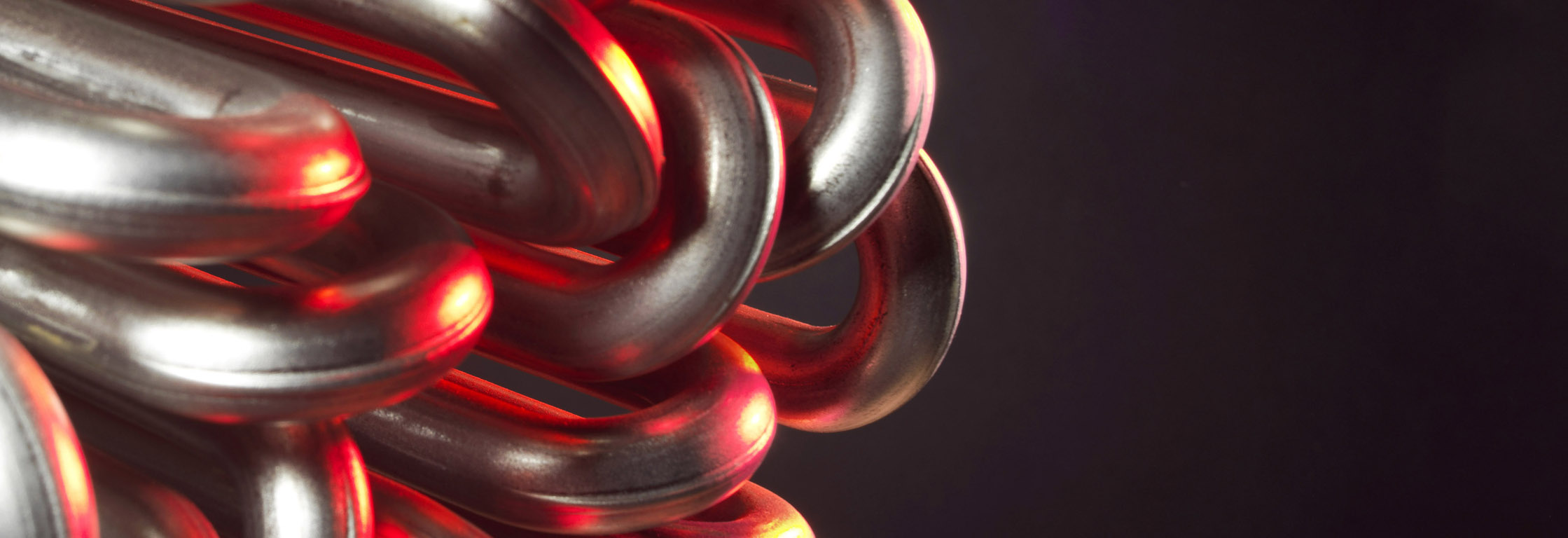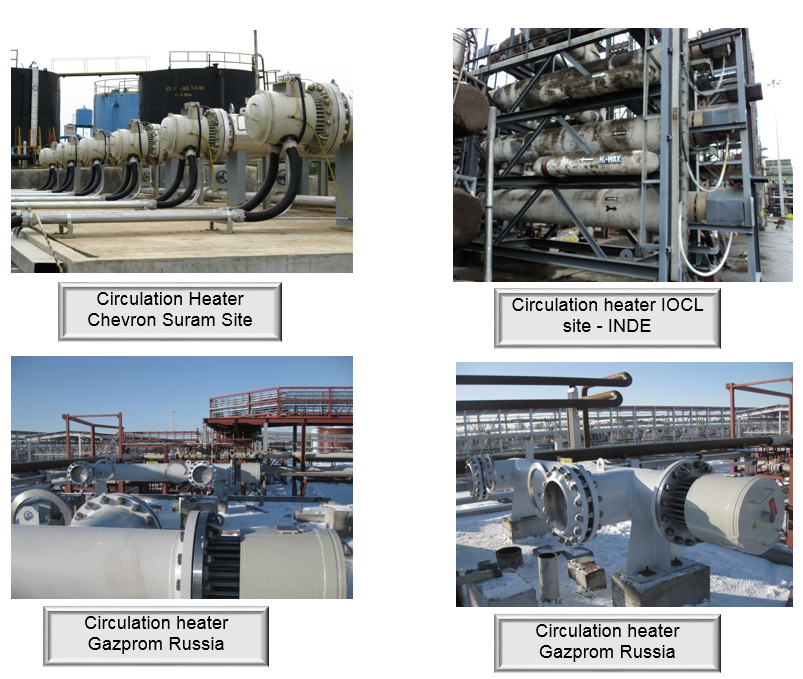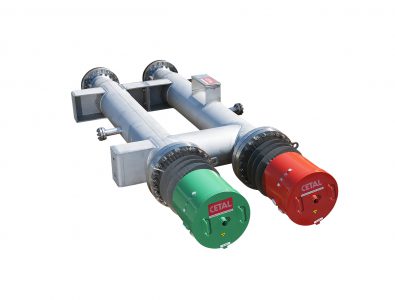
In-line circulation heaters
Product overview
- Power up to 5 MW (5 000kW)
- Watt density from 0,1 to 20 w/cm²
- Process temperature up to +900 °C
- Voltage max. 690 V
- Vessel in steel or stainless steel
- Construction code : CODAP, ASME
- Pressure up to 300 bars
Advantages
- Large range of materials and options according to customer process and conditions of use
- Benefit from CETAL’s 50 years of experience as designer and manufacturer!
- Equipment available for use in hazardous areas or safe environment
- The end-to-end control of the design and production chain allows us to deliver a product which suits your process perfectly.
Operating conditions
- Normal (non-ATEX)
- Hazardous areas (ATEX/IECEx) and NEC 505
- Extreme environments: – 60°C to + 80 °C
- Fluid: from – 270 °C (3 K) to 1000 °C
- Onshore / Offshore environment
- Salt atmosphere
- Pressure: 300 bars (PED)
- Vertical or horizontal mounting
Water
- Stagnant water, max load 8 -12 W/cm², material: copper, 321, 316L
- Circulating water, max load 10 -16 W/cm², material: copper, 316L, inc 800, inc 825
- Boric water, max load 8 W/cm², material: 316L
- Boiler water, max load 8 -16W/cm², material: 316L, inc 800, inc 825
- Chlorated water, max load 6 W/cm², material: inc 825
- Sea water, max load 3,5 -6 W/cm², material: inc 825, inc600
- Demineralized water / deionized / distilled / Softened,max load 4 -6 W/cm², material: 316L, inc 800, inc 825
- Domestic hot water, max load 4 -8 W/cm², material: copper, 316L, inc 825
- Caustic water (2%, 10%, <30%, 70%), max load 2,3-7W/cm², material: 316L, inc 825, inc 600
Oil
- Fuel oil pre-heating,light fuel oil, C fuel oil, max load 1 -2 W/cm², material: 321, 316L
- Heavy fuel, max load 0,5 -3,5 W/cm² accto grade, material: 316L
- Gasoline, kerosene,max load3,0-3,5 W/cm², material: 316L
- Machine oil SAE 10, 30, 40 &50, max load 2,0 -3,5 W/cm², material: 316L
- Mineral oil , max load 0,5 -3,5 W/cm² acc to temp, material: 321, 316L
- Lube oil, max load 2,3 W/cm², material: 321, 316L
Acid & corrosive fluid
- Acetic acid, max load 6W/cm², material: 316L, inc 825
- Boric acid, max load 6W/cm², material: inc 825
- Chloric, Hydrofluoric, Nitric, Sulphuric acid, max load 1,5W/cm², material: teflon coat
- Boric acid, max load 6W/cm², material: inc 825
- Alkaline bath, max load 6W/cm², material: 321 (no corrosive compound), 316L
- Phosphate bath, max load 4W/cm², material: 316L,inc 825
Glycol
- Ethylene glycol,Propylene glycol, 4 to 8 W/cm² acc to concentration, material: 321, 316L
Others
- Asphalt, tar, and other heavy or highly viscous compounds, max load 0,5 -1,5W/cm², material: 316L
- Milk, max load 0,3W/cm², material: 316L
Gas
- Air, max load 0,1 -8W/cm² acc. to sheath temp., material: 321
- Circulating air, max load 0,1 -8 W/cm² acc. to sheath temp., material: 309
- Natural gas, max load 0,1 -8 W/cm² acc. to sheath temp., material: 321, 316L
- Argon, nitrogen, W/cm² acc. to sheath temp., material: 321, 316L, inc 825, inc 600
- Propan, butane, W/cm² acc. to sheath temp., material: 321, 316L
- Oxygen, hydrogen, W/cm² acc. to sheath temp., material: 316L
Solids
- Oxychloration, max load 3 W/cm², material: inc800, inc 825
- Calcination, max load 3 W/cm², material: inc 800, inc 825
- HC regeneration, max load 2 W/cm², material: inc 800, inc 825
Technical description
CETAL manufactures its own heating elements which are the key components (active parts) of all electric heating systems. The design is defined according to customer specifications.
The watt density, tube diameter and the tube sheath are chosen to optimize the reliability and robustness (corrosion, temperature) of CETAL equipments.
Technologies
- Tubular heating element (most fo the cases)
- Heating rods into sleeve
Tube diameter & material
- Tube diameter: 6.5 / 8.5 / 10 / 13.5 / 16 mm
- Tube material:
- Stainless steel: AISI 321 (1.4541) / AISI 316L (1.4404) / AISI 309 (1.4828)
- Others: Incoloy 800 (1.4876) / Incoloy 825 (2.4858) / Inconel 600 (2.4816)
- Titanium
- Specific coating: TeflonTM (PTFE) / Halar
- Tube type: sealed tube, seamless tube (on request)
Manufacturing
- 100% of the components come high quality supplier from Europe
- 100% manufacture within CETAL factory

- Connection terminals
- Tube
- Insulation : magnesia oxyde (Mg O), to secure optimized heat transfer and electrical insulation.
- Resistance wire: Made of Nickel Chrome 80/20, it is the active part of the heating element (Joule effect)
- Cold length
- Sealing material: Keeps out external moisture. Different types (silicon, resins, cement) are used depending on the industrialapplication, the external medium and temperature.
- Output insulation: Made of steatite ou corundum, it provides dielectric insulation (creepage distance, distance in the air).
According to the process and environment conditions: steel, stainless steel or incoloy
- Standard documentation
- Certificate of conformity to the order
- Heater wiring diagram
- Instruction manual
- On-request documentation
- Supplied according to directives, standard and construction code
- Welder qualifications (QS)
- Welding qualifications (QMOS)
- PED documentation
- Material certificate 3.1 according to NF EN 10204
- Welding book; calculation note, hydraulic test report
- Electrical book
- According to CE European directives and CE market (for Europe)
- ATEX/IECEx certificate for component or system
- EAC CU TR, c CSA us (NEC 505)
- Construction code: CODAP, ASME
![]()
Electrical tests
- Power test by cold resistance measurement. Allowed tolerance: -5% and +10% of the nominal resistance value.
- Insulationtest, direct voltage 500 V, mini cold value is > 100 Megohms
- Dielectric test, (2U + 1000 V) x 1,2 during 1 second
- The stray current and the hot dielectric rigidity can be measured on a sample at operating temperature (on request).
- 100% of the heating elements are tested before shipment (Final control)
Mechanical tests
- Visual inspection
- X-ray test (if required)
- Liquid penetrant test
- Ultrasonic test
- Magnetic test
- Pressure control test
Dimensional test
- Critical dimension are tested
Other tests / operations
- Helium test (on request)
- Degreasing
- Argon cleaning
Third party
- Third party inspection (on request)
- Cleaning and pickling (Stainless steel)
- Sand blasting (Steel)
- Painting (Steel)
- Air drying
- Nitrogen inerting
- Bolts + nuts (+10% spares) and material
- Gaskets (hydro test , operation, spare)
- Flange nozzle plugs (plastic, wood …)
- WN Counter flanges for nozzle
- WN Counter flanges vent and drain
- Insulation


